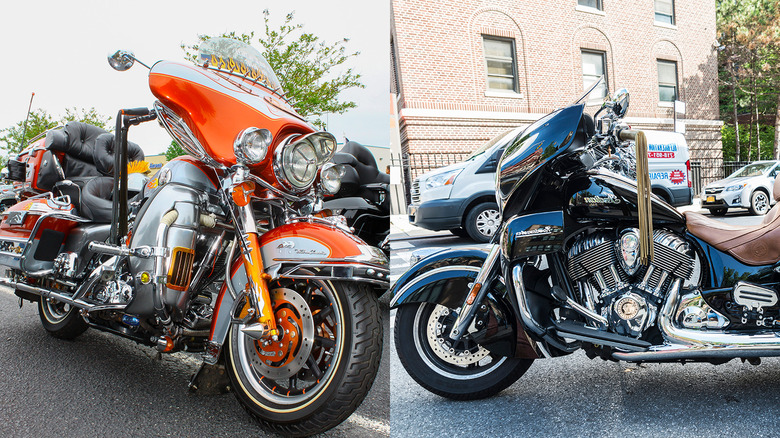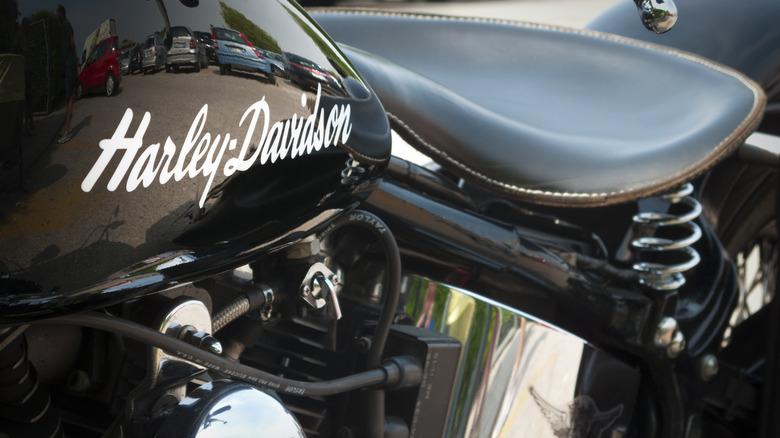
Barry Blackburn/Shutterstock and J2r/Getty Images
Harley-Davidson and Indian Motorcycles are two of the oldest brands in the business, cranking out bikes since 1903 and 1901, respectively. Harley has kept an unbroken line of production since the Model 1 became its first bike sold, but Indian took a break from 1953 through 2011 when Polaris purchased the brand. Both manufacturers use beefy V-Twin engines to power their machines, and they sit beside each other atop the pyramid of American motorcycle manufacturers.
Harley-Davidson and Indian earned their spots there by producing touring bikes like the Harley UltraClassic and Indian Roadmaster pictured above. These two models have a similar design with wide fairings, comfortable seating for two, and a healthy supply of chrome. Harley and Indian also make more stripped-down models like Harley’s $15,000 Sportster and the newest line of Indian Scouts, which range in price from about $13-17,000.
With so much in common, is there anything to distinguish the two makers from each other, and if so, which one comes out ahead? Judging by sales alone, Harley is the clear winner. More than 100,000 Harleys left North American dealerships last year, and the company earned almost $6 billion in revenue. Indian sold about 30,000 bikes last year, placing it outside the top five makers in U.S. market share.
Both brands have had models recalled
If we’re judging brands and not bikes, Harley’s superior sales numbers and uninterrupted production timeline make it a clear winner. Most bikers and prospective buyers care more about the performance and reliability of the machines than the corporate history behind them, though. Harley and Indian both cover new motorcycles with a two-year, unlimited mileage warranty that can be extended at an additional cost. Currently, both manufacturers state that warranty service must be done at a company dealership, but Harley is in hot oil with the Federal Trade Commission because the language in their warranty is in violation of the 1975 Magnuson-Moss Act, which grants owners the right to service their own machines and use third-party parts.
Indian motorcycles have been the subject of 295 NHTSA recalls, although most of them came before Polaris took over the badge. Indian’s most troublesome model is the 2001 Scout, with seven recalls issued. The most alarming was one involving the bolts that hold the front axle onto the fork, which could come loose and cause a dangerous crash. More than 2,000 recalls have been issued for Harley-Davidson motorcycles, but this discrepancy likely has more to do with the difference in the number of bikes the two companies have produced than an endemic lack of craftsmanship on Harley’s part.
[Featured image by Bob Adams via Wikimedia Commons|Cropped and scaled|CC-By 2.0]
Harley and Indian motorcycles match up fairly evenly
Harley’s most problematic model, the 1980 1340 Electra Glide, has faded from most owners’ memories. It was also the subject of seven recalls, although none were as alarming as the 2001 Scout’s axle mount issue. Harley-Davidson did have two major safety-related recalls in 2023 that affected tens of thousands of bikes. Nearly 1,500 2023 Street Glide models were recalled for an aerodynamic issue that could cause loss of control at speeds above 100 miles per hour, and 65,000 Softails were recalled because of a potential issue with the rear shocks that could cause a sudden loss of tire pressure.
These recent issues notwithstanding, Harley has the more recognizable emblem and maintains a larger customer base. That is partly due to Indian’s long break in production, but the brand’s purchase by Polaris could signal a resurgence.
Mercedes Streeter of The Autopian recently hopped on a 2023 Indian Challenger Dark Horse, and couldn’t help comparing it favorably to the Harley-Davidson Road Glide.
«Indian Motorcycle has the rides to go up against Harley’s best,» she wrote, noting that the Challenger had a touch more power than the Road Glide, along with a better infotainment system. In Streeter’s opinion, Indian’s recent resurrection and the rekindled rivalry between it and Harley benefits riders most of all. «Harley-Davidson’s and Indian’s renewed competition has produced some incredible motorcycles on both sides,» she concluded.
Harleys run hotter than Indians
While Streeter resisted putting either Harley-Davidson or Indian ahead of the other brand, Mark Vaughn of Autoweek compared Harley’s Road Glide Limited to the Indian Dark Horse Pursuit (shown above) and did not hesitate to declare a favorite. Although he found the Road Glide sufficiently comfortable and torquey, he noted that its V-twin engine produced a leg-roasting amount of heat. He measured the temperature of the Harley’s exhaust pipe to be almost 200 degrees hotter than the Indian’s.
Vaughn found the Indian to be more responsive to twists of the throttle than the Harley, but felt the Road Glide offered a marginally better riding posture. » You lean just a little farther forward on the Indian,» he wrote.» Both are entirely comfortable seating positions, just a bit more so on the Harley.» In the end, he declared the Dark Horse the winner in this head-to-head competition based on its crisp performance and cooler exhaust, but admitted the two brands ran wheel-to-wheel in most respects.
Whether you choose an Indian or Harley-Davidson for your next ride will be more a matter of personal preference than any vast difference between the two brands. They both offer proud traditions, robust dealer support, and a broad selection of bikes. The biggest distinction is the jagged lineage of Indian in comparison to the relatively stable history of Harley-Davidson. Harley has been cranking out bikes steadily since the early 20th Century, while Indian has existed that long in name only and now lives on only under the Polaris umbrella.
Test ride as many bikes as possible before making your decision

Vesilvio/Getty Images
Polaris began in the 1950s as a snowmobile manufacturer, and took custody of Indian barely a dozen years ago. That lack of motorcycle pedigree could push some buyers to Harley if they’re concerned about the future of the Indian brand. Hegshot Rides did an in-depth comparison of Harley-Davidson and Indian and pointed out some clear differences between the two brands. In his opinion, Indian bikes offer more for the money, but he prefers the look of Harley-Davidsons.
In his experience, Indian dealers had been more helpful, but he also noted that peer support for Harley owners was far better based on its superior sales numbers. Like the differences noted by Mark Vaughn, his were mostly a matter of personal preference. If you’re having trouble deciding between a Harley-Davidson and an Indian motorcycle, our best advice is to visit local dealerships to get a feel for the level of service they will provide and test ride as many models as you can. Whichever brand you choose, you can rest assured that you are getting a well-built, solidly backed machine with a large community of fellow riders.